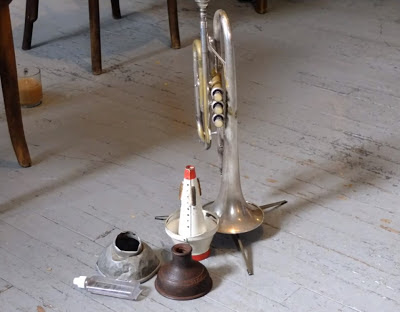 |
| CORNET - a B Flat Instrument (so its 'C' sounds the same note as a piano's 'B Flat') |
I have had an enquiry from a reader. He says I wrote that Michigander Blues is normally played in the key of D minor. But when he tries it on his trumpet it seems to be in his key of E minor.
So let me explain that several instruments used in traditional jazz are transposing instruments, which means that music written for them appears to be in one key but when played it sounds in a different key. Most trumpets, for example, are Bb instruments, so if you play C on such a trumpet, you will produce the same note as Bb on the piano. The same is true of most clarinets.
You also come across Eb instruments, such as some tubas and saxophones. This means that if you play C on one of these instruments, it will sound the same note as Eb on the piano.
So my trumpet player - performing Michigander Blues in HIS E minor - is actually playing it in D minor (concert pitch - as sounded on the piano).
Why have instrument manufacturers made matters so complicated? It's simply because they have found - over many decades of trial and error - that the tuning and fingering on the transposing instruments are better if they are built in such a way.
As a player of a Bb trumpet or Bb clarinet, you should in my opinion always refer to the concert key in which you are playing a piece of music with your band. Don't confuse the rest of the band by mentioning your own personal key. So, for example, if the band decides to play Michigander Blues in D minor, then D minor it is, even though you know that you personally will be playing it in your instrument's E minor.
To put it another way, you will always be one tone higher than the 'concert key' that the pianist or banjo or guitar player uses.
So for example if the band announces that it is going to play Muskrat Ramble in Ab, you know immediately that you will be playing in your Bb.
Maybe this sounds tricky, but after a short time such thinking becomes automatic.
Here's Shaye Cohn's Bb cornet. When she plays C on this, it sounds the same note as the Bb on a piano or banjo.
Here she is playing Michigander Blues. You can hear that the band is playing the tune in D minor. But if you watch Shaye's fingers, you will notice that she personally is of course having to play it in the cornet's E minor:
CLICK HERE.
CLICK HERE.
